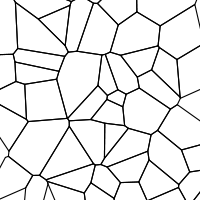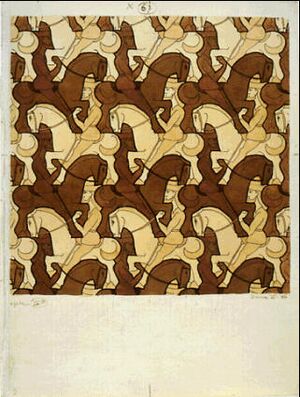Introduction to Tessellations

Tessellations
A tessellation is a covering of the plane by shapes, called tiles, so that there are no empty spaces and no overlapped tiles. Tessellations are also called tilings.
Some tessellations involve many types of tiles, but the most interesting tessellations use only one or a few different tiles to fill the plane. In particular, tessellations that use only one kind of tile are called monohedral.
If the tiles are regular polygons (all sides are congruent and all angles are congruent) and vertices only meet vertices we say that the tessellation is a regular tessellation.
An example of tessellations using only a few different tiles are the semi-regular tessellations. These tessellations are made up of two or more types of regular polygons, vertices only meet vertices and the configuration around every vertex is the same.
Some examples of tessellations and their tiles:
 |
 |
 |
 |
The rectangle tile tessellation is monohedral, since every tile is the same shape and size. The tessellation by + shapes is monohedral. The Penrose tiling is not monohedral. The tessellations shown here are neither regular nor semi-regular.
The theory behind tessellations we need in this course - including regular and semi-regular tessellations - is covered in Tessellations by Polygons.
Explorations
For a basic introduction to tessellations see:
More detailed explorations will be covered in Tessellations by Polygons.
Escher's Tessellations
Creating tessellations of the plane by recognizable figures was Escher's first groundbreaking artistic technique. He called it the regular subdivision of the plane, or regelmatige vlakverdeling in his native Dutch. Escher's works feature complex and whimsical figures, mostly animals, which magically interlock to cover the printed page. Creating these mathematically constrained outlines is no easy process, and Escher was unquestionably the master. His technique was to start with a simple tessellation by geometric shapes, and then evolve it into a recognizable figure. Escher writes[1]:

- One can divide a plane into geometric shapes according to certain systems; these forms can become infinitely varied and very complex and still meet the requirement of filling the plane with congruent forms in rhythmic repetition without leaving any 'void.' If one then tries to mold the form so as to evoke an association with something familiar to the viewer - an object, an animal, or whatever it might be - it becomes a compelling game in view of the infinite possibilities offered as well as the rigourous restrictions imposed by the rules. It is a painstaking process of groping and fumbling about. Sometimes not a single one of the patterns that appear at the end were consciously sought at the start. It dawns on you slowly. Then comes the moment when you recognize it when you suddenly realize - and here we shift from a general impression to a specific one -: it is a man on a horse! After this, he develops rapidly under the impact of certainty.
Here, Escher lays out his methods for creating tessellations:
- Begin with a tessellation by geometric shapes.
- "Mold the form". Here, he bends and manipulates the straight lines of the geometric scaffolding.
- Look at the resulting pattern and attempt to recognize a figure.
- Push the pattern towards the desired shape.
Not only was this Escher's process for creating tessellations, but also the theme of many of his artworks. Escher wants his audience to see and understand the process behind the patterns, and often presents prints with story like transitions from geometric to recognizable tessellations. You can investigate the passage from geometry to art in Metamorphosis Exploration.
What makes the creation of tessellations a "compelling game" is the interplay between "molding a form" and attempting to recognize a figure in it. We shall see that it is quite difficult to create a tessellation with a preconceived subject or motif, but easy to make interesting looking shapes that, after the fact, can be decorated and enhanced to look like something.
Several techniques explaining how to create the Escehr like tessellations will be covered in the section Tessellations by Recognizable Figures. As a first step, however, we must learn more about Tessellations by Polygons.
Relevant examples from Escher's work
- Eight Heads
- Lion and bat patterns on fabric, Visions of Symmetry Pg 11
- Experiments with Haag's paper, Visions of Symmetry Pg 27-29
- Regular divisions of the plane poster, Visions of Symmetry Pg 32
- Sketches of a horseman, Visions of Symmetry Pg 111
- Experiments with stamped block tessellations, Visions of Symmetry Pg 44-52
- Regular Division of the Plane Drawings
- Cycle
- Day and Night
- Liberation
- Metamorphosis I
- Metamorphosis II, Metamorphosis III
- Verbum
Tessellation Resources
- Graph paper generator by Incompetech.
- Introduction to Tessellations by Dale Seymour and Jill Britton. An excellent text for grade school teachers.
- Tilings and Tessellations by Science U.
Notes
- ↑ Visions of Symmetry, pg 110

